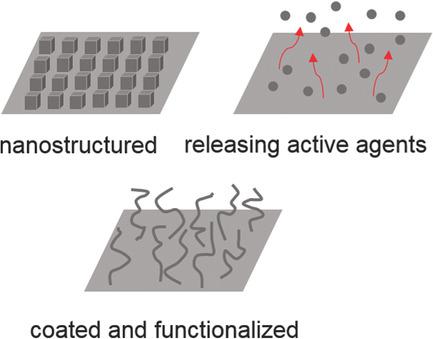Our official English website, www.x-mol.net, welcomes your feedback! (Note: you will need to create a separate account there.)
Nanoscience‐Based Strategies to Engineer Antimicrobial Surfaces
Advanced Science ( IF 15.1 ) Pub Date : 2018-03-08 , DOI: 10.1002/advs.201700892 Serena Rigo 1 , Chao Cai 2 , Gesine Gunkel-Grabole 1 , Lionel Maurizi 1 , Xiaoyan Zhang 1 , Jian Xu 2 , Cornelia G Palivan 1
Advanced Science ( IF 15.1 ) Pub Date : 2018-03-08 , DOI: 10.1002/advs.201700892 Serena Rigo 1 , Chao Cai 2 , Gesine Gunkel-Grabole 1 , Lionel Maurizi 1 , Xiaoyan Zhang 1 , Jian Xu 2 , Cornelia G Palivan 1
Affiliation

|
Microbial contamination and biofilm formation of medical devices is a major issue associated with medical complications and increased costs. Consequently, there is a growing need for novel strategies and exploitation of nanoscience‐based technologies to reduce the interaction of bacteria and microbes with synthetic surfaces. This article focuses on surfaces that are nanostructured, have functional coatings, and generate or release antimicrobial compounds, including “smart surfaces” producing antibiotics on demand. Key requirements for successful antimicrobial surfaces including biocompatibility, mechanical stability, durability, and efficiency are discussed and illustrated with examples of the recent literature. Various nanoscience‐based technologies are described along with new concepts, their advantages, and remaining open questions. Although at an early stage of research, nanoscience‐based strategies for creating antimicrobial surfaces have the advantage of acting at the molecular level, potentially making them more efficient under specific conditions. Moreover, the interface can be fine tuned and specific interactions that depend on the location of the device can be addressed. Finally, remaining important challenges are identified: improvement of the efficacy for long‐term use, extension of the application range to a large spectrum of bacteria, standardized evaluation assays, and combination of passive and active approaches in a single surface to produce multifunctional surfaces.
中文翻译:

基于纳米科学的抗菌表面设计策略
医疗器械的微生物污染和生物膜形成是与医疗并发症和成本增加相关的主要问题。因此,越来越需要新的策略和利用基于纳米科学的技术来减少细菌和微生物与合成表面的相互作用。本文重点关注纳米结构、具有功能涂层并产生或释放抗菌化合物的表面,包括按需产生抗生素的“智能表面”。成功的抗菌表面的关键要求包括生物相容性、机械稳定性、耐久性和效率,并通过最新文献的例子进行了讨论和说明。描述了各种基于纳米科学的技术以及新概念、它们的优点和悬而未决的问题。尽管处于研究的早期阶段,基于纳米科学的抗菌表面策略具有在分子水平上发挥作用的优势,有可能使其在特定条件下更有效。此外,可以对界面进行微调,并且可以解决取决于设备位置的特定交互。最后,确定了剩余的重要挑战:提高长期使用的功效、将应用范围扩展到大范围的细菌、标准化的评估分析以及在单个表面中结合被动和主动方法来生产多功能表面。
更新日期:2018-03-08
中文翻译:

基于纳米科学的抗菌表面设计策略
医疗器械的微生物污染和生物膜形成是与医疗并发症和成本增加相关的主要问题。因此,越来越需要新的策略和利用基于纳米科学的技术来减少细菌和微生物与合成表面的相互作用。本文重点关注纳米结构、具有功能涂层并产生或释放抗菌化合物的表面,包括按需产生抗生素的“智能表面”。成功的抗菌表面的关键要求包括生物相容性、机械稳定性、耐久性和效率,并通过最新文献的例子进行了讨论和说明。描述了各种基于纳米科学的技术以及新概念、它们的优点和悬而未决的问题。尽管处于研究的早期阶段,基于纳米科学的抗菌表面策略具有在分子水平上发挥作用的优势,有可能使其在特定条件下更有效。此外,可以对界面进行微调,并且可以解决取决于设备位置的特定交互。最后,确定了剩余的重要挑战:提高长期使用的功效、将应用范围扩展到大范围的细菌、标准化的评估分析以及在单个表面中结合被动和主动方法来生产多功能表面。



























 京公网安备 11010802027423号
京公网安备 11010802027423号